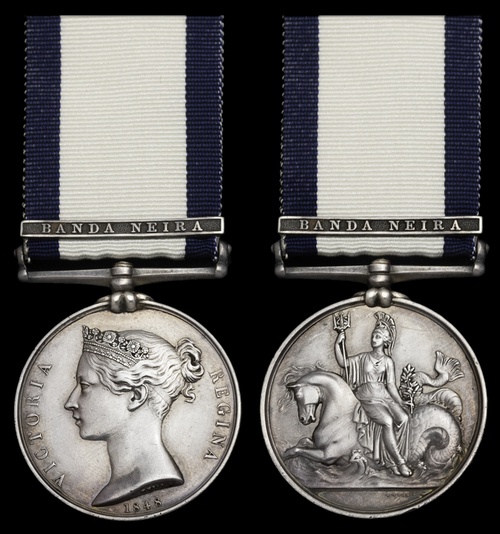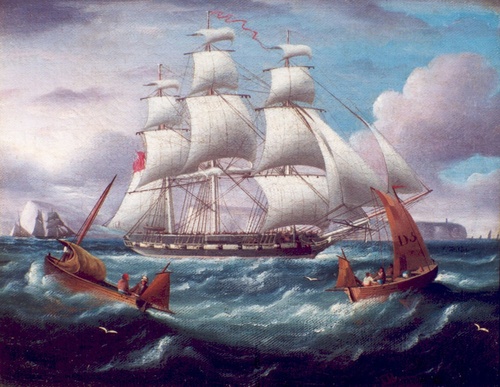Auction: 25001 - Orders, Decorations and Medals
Lot: 2
(x) A rare 'Banda Neira' Naval General Service Medal awarded to Sailmaker's Mate R. Cheeseman, Royal Navy, who served aboard H.M.S. Caroline and with her participated in the impressive action of 18 October 1806, fought pirates in the Persian Gulf, took part in the heroic capture of Banda Neira under Captain Cole, was wounded by a musket ball to his left arm near Java, and later as Captain of the Afterguard served off the coast of Canada in the War of 1812
Naval General Service 1793-1840, 1 clasp, Banda Neira (Robert Cheeseman.), light contact marks and a slight edge bruise, otherwise good very fine
Provenance:
Whitaker Collection, 1890.
Glendining's, June 1986.
Noonan's, July 2021.
Robert Cheeseman is confirmed on the roll with entitlement to this medal and clasp for his service as Sailmaker's Mate aboard H.M.S. Caroline during the capture of Banda Neira. He is one of only 68 recipients of this clasp, and the sole Sailmaker's Mate.
Cheeseman was born at Deptford, London circa 1783 and found work as a bricklayer prior to entering the Royal Navy on 23 March 1803, aged twenty. His first posting was aboard the 36-gun fifth-rate frigate H.M.S. Caroline, launched at Rotherhithe in 1795. Initially ranked as a Landsman upon his enlistment, Cheeseman must have been a capable sailor as he found steady promotion to positions of responsibility throughout his eleven years of service.
Caroline was captained by Benjamin William Page when joined by Cheeseman, and set sail for the East Indies in May 1803 with secret orders to bring news of the start of the Napoleonic Wars. Whilst en route she captured a number of vessels, including the Dutch Haasje which had been carrying dispatches from Napoleon. Haasje was sent in to the remote island of St. Helena, which would of course later host the exiled French Emperor, bringing the news of war. She arrived in the East Indies on 6 September and spent the next several months escorting East India Company convoys and capturing French privateers. For Caroline's success in the capture of many enemy privateers, the grateful merchant communities of Madras and Bombay presented Captain Page with swords worth 500 guineas, no small sum with a value of over £60,000 today.
At an unknown date Cheeseman was wounded by a musket ball to his left arm while serving in the South Seas in the Strait of Sunda, between the islands of Java and Sumatra. The circumstances surrounding this wound are unknown, but it was later noted in his pension register.
East Indies and the Action of 18 October 1806
Cheeseman had his first promotion to Ordinary Seaman on 1 January 1805, with command of Caroline transferred in April to Captain Peter Rainier - who was only twenty years old at the time of his appointment. It is worthy to also note that until mid-1805 James Johnson, later physician extraordinary to King William IV, was acting as the ship's surgeon and his time aboard her was essential in gathering material for his influential publications on tropical diseases.
Caroline found great success during the Java Campaign of 1806-7, and with young Captain Rainier at her helm fought the action of 18 October 1806 against a Dutch squadron. While patrolling off the coast of Batavia Caroline captured a small Dutch brig, whose crew informed Rainier that the frigate Phoenix was under repair and vulnerable nearby. The captain resolved to bring her out, but while on approach was spotted by two small warships. Caroline then captured the 14-gun brig Zeerop without firing a single shot, while the other escaped by hugging the coast. Phoenix took the opportunity of the delay to sail to the well-defended Batavia harbour. Whilst in pursuit of Phoenix, Caroline sighted at anchor in the Batavia Roads the 36-gun frigate Maria Reijersbergen along with three smaller warships.
Facing a force significantly stronger than Caroline and with the ability to call on the harbour gunboats for aid, the confident Rainier immediately made for Maria Reijersbergen. The gallant Captain himself takes up the story in his report to Rear-Admiral Sir Thomas Troubridge:
'As I distinctly made out the frigate to be the largest ship in the road, I ran for her with springs on both cables [allowing her to easily turn at anchor]; the enemy commenced firing at us as soon as we were within gun-shot, which was not returned till we came as close as the wind would allow us, which was within half-pistol-shot, when we opened our fire. The action continued about half an hour, when the enemy hauled down her colours. On boarding, she proved to be the Dutch republican frigate Maria Reygersbergen, of 36 guns, 18-pounders on the main-deck, and 270 men, commanded by Captain Jager, second in command. The Maria was launched in 1800, and is a fast sailing ship. We had to encounter, besides the frigate, the William of 20 guns, Patriot 18, and Zeeplong 14, with several gun-boats; and there were thirty gunboats lying in shore, which did not attempt to come out. I beg leave to state, that when the action commenced we were short of complement, by men away in prizes, sick at hospitals, &c. 57 in number.'
The British suffered only three killed and eighteen wounded, while the enemy sustained over fifty casualties. The shallow water did not allow her to safely attack the others but the enemy ships, as well as a further six merchant vessels, nevertheless ran themselves aground to escape capture by Caroline. Maria Reijersbergen was later brought into the service of the Royal Navy as H.M.S. Java.
Cheeseman was advanced Able Seaman a couple of months after the engagement on 15 December. Caroline was next involved in an exciting exchange on 27 January 1807 after convoying near the Philippine Islands. Spotting a strange sail, she made chase and when within range the 16-gun ship raised Spanish colours and opened fire. Rainier opened fire in turn and forced her surrender after inflicting twenty-seven casualties. The mystery vessel's identity was revealed as St. Raphael sailing under the alias Pallas, carrying a valuable cargo which included £500,000 of bullion coin and 1,700 quintals of copper. In capturing this treasure ship Caroline suffered but seven men wounded.
By June, Caroline joined the squadron of Rear-Admiral Edward Pellew. She was sent along with the frigate H.M.S. Psyche on a mission to find Dutch ships which escaped destruction at the Batavia Roads. The two captured a smaller enemy vessel near Surabaya in August, who revealed to the British that there were a number of Dutch ships of the line in a state of disrepair at the port of Griessie. After a reconnoitre of Griessie, Psyche and Caroline destroyed a number of merchant ships and shared in the capture of Dutch corvette Scipio, later brought into Royal Naval service as H.M.S. Samarang.
In September, command of Caroline passed to Captain (later Rear-Admiral) Henry Hart who sailed her along with the rest of Pellew's squadron back to attack the ships at Griessie. During the attack, Caroline was for some time used as Pellew's flagship after the grounding of Culloden. Hart was charged with orchestrating the landing parties and he successfully coordinated the raid on Griessie and the destruction of the port's infrastructure. This action brought to an end the presence of an active Dutch navy in the East Indies.
Hart was replaced by Captain Charles Gordon at the close of the year, and shortly afterwards on 14 January Cheeseman was advanced Sailmaker's Mate. However, for reasons unknown, he reverted to Able Seaman in June. November 1809 saw Caroline sent to the Persian Gulf to reinforce operations against pirates. She assisted in the destruction or capture of over eighty pirate vessels that same month at the pirate stronghold of Ras-al-Khyma. During this attack she sailed alongside H.M.S. Chiffonne and some East India Company vessels, which landed their troops while the town also faced a bombardment by sea. Before nightfall the town was ablaze and all the pirate ships were destroyed, with only one man wounded aboard Caroline.
The Capture of Banda Neira
Captain Christopher Cole was given command of Caroline early in 1810 following his participation in the Java Campaign, and with her took part in the British invasion of the Franco-Dutch held Moluccas - the Spice Islands. These islands were the exclusive producers of nutmeg and mace and offered the British a valuable opportunity to gain control over the rich Dutch spice trade. This campaign culminated in Cole's heroic seizure of the well-fortified island of Banda Neira, where they arrived on 9 August. Cheeseman had regained the rank of Sailmaker's Mate on 10 July, just one month prior to the action which earned him his clasp.
The goal of the operation was to disembark the landing force, which totalled less than 400 men, in small boats after dark. The boats would run into the harbour and the men would approach Fort Belgica, strategically built at elevation and surrounded by a ditch, and together would take it in a surprise attack. However, the plan did not proceed accordingly as foul weather affected the boats and the element of surprise was lost when they were discovered and fired upon during the night. Less than half the initial force was even able to make it to Fort Belgica; Captain Cole launched the attack regardless. The heavy rain worked to their advantage as they pressed towards the fort with boarding pikes, with the enemy's visibility reduced and their firearms rendered ineffective. The impressive story is expanded upon by Lieutenant C.R. Low in The Great Battles of the British Navy:
'And before the end of the summer, Captain Cole, of the Caroline, 36, with the Remonstrance, 38, Captain Foote, and the Barracouta, 18, Lieutenant Kenah, achieved a glorious success in the reduction of Banda, the chief of the Spice Islands. Disembarking less than 400 men, half of whom missed their way back in the dark, he first scaled the strong castle of Belgica, and then gained possession of the castle and town of Nassau, and forced the garrison of 700 Regulars and a large body of Militia to lay down their arms. This almost unique feat of arms, by which two castles and 10 Batteries, amounting to 138 guns, fell into British hands, was accomplished with only 140 sailors and 40 soldiers, and without the loss of a single man. Captain Cole was knighted, and received the Thanks of the Admiralty, Commander-in-Chief and Governor-General, and four Swords of Honour, one of which, with a letter from the crew of the Caroline, must have been especially gratifying to this dashing Officer.'
Following the surrender of Banda Neira, Caroline proceeded to Bombay for a refit and Captain Cole was next tasked with drafting preparations for the 1811 invasion of Java prior to the arrival of Rear-Admiral Robert Stopford. Cheeseman was promoted to Yeoman of the Powder Room on 20 June 1811, just two months prior to the arrival of the Rear-Admiral and his fleet at Chillingching Bay, near Batavia, on 4 August. Cole in Caroline led the frigates charged with covering the debarkation of the 8,000 troops with their guns and supplies. Cole's decision to land the forces immediately proved a prudent one, as if they had waited they would have been subjected to fire from the alerted Dutch forces. Following the successful invasion, Caroline was tasked with carrying Rear-Admiral Stopford's discharges back to England, where she arrived on 15 December. The 94-day voyage was the second fastest from the East Indies recorded at that time.
During Cheeseman's time aboard Caroline, she was credited as orchestrating or assisting with the capture or destruction of 27 enemy ships (excluding pirate vessels), including two 68-gun ships of the line. Such successes and heroic deeds as those achieved by Caroline during her service in the East Indies are often confined to fictitious tales, and her crew and Captains must have been incredibly capable even within the standards of the well-trained Royal Navy.
Cheeseman is confirmed to have served aboard Caroline until January 1812, and as such his presence during the Java campaign would have been entitled to a clasp for Java. However, for unknown reasons Cheeseman did not claim the clasp despite having completed the required service.
War of 1812
Finally back home at Portsmouth, Caroline was paid off and later fitted as a salvage ship. After having spent nearly the past decade serving aboard Caroline, Cheeseman was posted to 44-gun frigate H.M.S. Pomone on 12 January 1812. Pomone had recently begun her life in the Royal Navy in 1811, having originally been in the service of the French Navy as Astrée before her capture by the British in 1810. Cheeseman would have joined her in Portsmouth, where she was docked until sailing for Newfoundland, Canada in May under the command of Captain Francis William Fane to participate in the War of 1812. On 1 May, Cheeseman was promoted to Captain of the Afterguard. He thus served in this capacity during the War of 1812 off the coast of North America and was present on 4 September when Pomone recaptured Kitty and carried her into Newfoundland. Kitty had been captured by the American privateer schooner Rossie a few days earlier on 31 August as she was sailing from Greenock to New Brunswick. Rossie herself would later be captured by the British the following year.
Cheeseman left Pomone on 12 December 1812, after serving with her for just under one year's duration, and joined H.M.S. Puissant the following day. The same day he joined Puissant he reverted back to Able Seaman. Like Pomone, Puissant was originally a French vessel that had been brought into the service of the British Royal Navy. A 74-gun ship of the line launched in 1782, upon being handed over to the British in 1794 she thereafter remained in Portsmouth harbour as an unarmed receiving ship. As such, Pomone had represented Cheeseman's final posting at sea.
He was with Puissant at Portsmouth for about a year and a half until his final posting to H.M.S. Gladiator, a 44-gun fifth rate which spent her whole career on harbour service and notably hosted numerous court martial trials. Cheeseman was with her only briefly from 26 July 1814 until his discharge on 8 August, having served for over 11 years in the Royal Navy. He became eligible for pension in 1841 when he was 59 years old, and is recorded as having previously been married at Shoreditch with an issue of three sons and two daughters; sold together with copied research including medal roll.
Subject to 5% tax on Hammer Price in addition to 20% VAT on Buyer’s Premium.
Estimate
£4,000 to £5,000
Starting price
£3200









